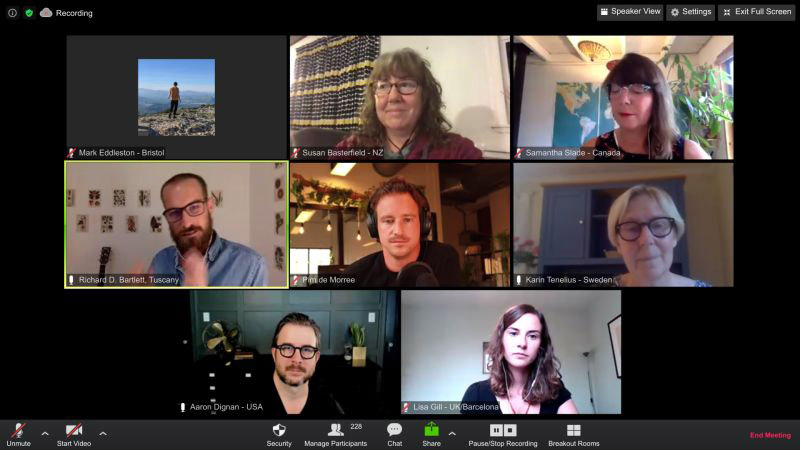What waters have you been swimming in lately? Recently, I had the pleasure of attending a “Fishbowl” Meetup hosted by Mark Eddleston, cofounder of Reinventing Work. The topic was new ways of working, the future of work, and self-managing organizations. All topics closely related to the world of “Agile” and “agility,” and at the same time, their own movements. Mark’s idea was to assemble seven authors of great books on the future of work, and see where the conversation might lead.

The fishbowl included
- Aaron Dignan, author of Brave New Work
- Karin Tenelius & Lisa Gill, authors of Moose Heads on the Table: Stories about self-managing organisations from Sweden
- Pim de Morree, author of Corporate Rebels: Make Work More Fun
- Richard Bartlett, author of Patterns for Decentralised Organising
- Samantha Slade, author of Going Horizontal
- Susan Basterfield, author of Better Work Together.
The agenda was simple and elegant. After a brief check-in with each author, the group explored the “good, the bad, and the ugly” of working in more horizonal, self-managed ways. In other words – working in ways that diverge from traditional top-down, hierarchical organizations. My top 7 thought-provoking points from the fishbowl are
- More Resilience – One of the biggest “good” aspects of self-managing ways of working is that they appear to be much more resilient in the face of a crisis like Covid-19. Aaron noted that companies who have been on this journey for a while have been able to thrive, pivot and adapt, while more traditional organizations seem to be “brittle.” It’s striking how human development accelerates is when we work together in this way. It’s a mind shift. We all see the business as “ours” and we work on it together. And then we step into things that we might not usually attempt. Skills and talents get revealed and developed as we work as a self-directed community that is learning continuously.
- More Belonging – Pim noted that one of the benefits of self-managing organizations is that people feel like they are part of the business, even in tough times. There’s more commitment to the company’s purpose and to finding creative solutions to current challenges together. All the brains in the room are actively working together on the problem, instead of most brains idling, waiting for direction from the leader.
- More Perspective – Aaron noted that most of corporate’s traditional ways of working arrived on the work scene quite some time ago. As an example, the Gantt chart was invented long before women had the right to vote. Hierarchical ways of working are deeply ingrained in our societal understanding of how “work works.” In some ways – these perspectives are much like water in the fishbowl – how aware are the fish that there are alternatives to the dirty water where they have been swimming? We have been conditioned for hierarchy from birth. Lisa asked “how do we start to ‘unlearn’ so much of what we have taken as true?” How do we relearn how to work together?
- More Persistence & Patience – Karen noted that these ways of working are not as awkward or weird anymore. They are more accepted. It’s a paradox – acceptance comes quickly in grass roots organizations, and at the same time – it takes time to fully permeate an organization. Sometimes a long time.
- More Change – Karen noted that, “Change is easier when you involve people.” The question at hand is how do we get to the tipping point where “new” ways are the norm, and not the exception? Can we have self-managing organizations at scale? What if it takes 300 years? For now, we need to learn to surf extreme uncertainty and seize crossroads moments to courageously embrace new possibilities. We don’t need a framework so much as the simple recognition that each organization will uniquely evolve to flourish in the future of work. In other words – in the change department, one size or framework does NOT fit all.
- More Mice – one of the most effective approaches to change at this scale is to look for “Trojan Mice” – micro-changes can lead to micro-habits that add up to larger sustained change in a workplace. Aaron noted that organizations are not static and the membranes are very porous. A changed mind is a changed mind, and even if the organization doesn’t setup residence under a rainbow, there is still value in changed minds working together in better ways. It adds up.
- More Inspiration – “Micro-moments of people being together & working together in new ways – that’s what it’s about.” – Lisa Gill
Quite a lot of ideas and great conversation in a mere sixty-minutes. If you’re curious to see the whole conversation, a link to the Fishbowl is here on YouTube. Many thanks again to Mark for organizing this conversation. I’m looking forward to what you instigate next!
